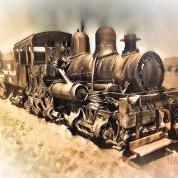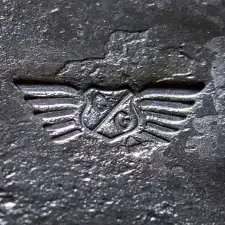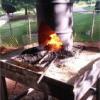
Buzzkill
Members-
Posts
2,049 -
Joined
-
Last visited
Profile Information
-
Gender
Male
-
Location
Central Illinois
Recent Profile Visitors
6,402 profile views
-
Forge heat treat baffle design
Buzzkill replied to ymber's topic in Heat Treating, general discussion
In another thread you were specifically talking about heat treating stainless. If you are using a good stainless alloy for knife blades you may need to bring the steel in the 1900 to 2050 degrees F range before quenching. You also may need to hold it at a high temperature for an extended period of time depending on the specific alloy. A muffle with a little bit of charcoal in it is not likely to prevent decarb in that scenario. A lot of people who heat treat stainless alloys use a stainless foil pouch with as much air pressed out as possible and a small amount of something flammable to consume the remaining oxygen in order to protect the stock from decarb. I'm not sure it's a problem to have the spine touch the muffle floor though. In order to try to get even heat I can understand why you wouldn't want a blade leaning against a wall of the muffle, but there are fairly easy ways to accomplish that. I've used small pieces of insulating fire brick in which I cut slots to hold blades where I wanted them. As Frosty suggested, you can also use kiln furniture, and I believe there are some knife making websites that actually sell pre-made items to hold blades while heating for quench or during tempering cycles. -
The appropriate lining thickness depends on a few things. If it's a small forge where you are dealing with odd-shaped pieces, and/or you are a little clumsy, then you need a lining that can take a little abuse - which translates into a little extra thickness. Generally speaking, it's a good idea to have the floor a little thicker than the walls due to the constant abrasion of stock being moved in and out. The thicker your lining is, the longer it will take to bring the forge chamber up to temperature - which translates into extra fuel cost. The upside is that if you do long forge sessions with a thicker lining it will act a little bit like a "heat battery" in the sense that once hot it will retain and radiate heat back into the forge more than a thin lining. So, ultimately how you plan to use your forge determines what is best for you. If you are dealing with mostly straight pieces where you are unlikely to gouge the walls, then thinner is probably better. This is especially true if you will usually be doing relatively short duration forging/heating sessions. Personally I do not see any real advantage to going 3/4" thick. For the floor that's not outrageous, but even there it's a little on the high side in my opinion.
-
Oatey high heat (2500 degree) furnace cement bubbling
Buzzkill replied to smeeldog's topic in Insulation and Refractories
Congrats on a successful pour! Sounds like you are well on your way to a long-lasting addiction. There is definitely a sense of accomplishment and satisfaction that you can get from working with your hands to create something you like that you just can't usually get by sitting at a desk. If you have the time and ability to post a picture (or a few) of your build and your casting I'd love to see it as well. -
I don't run 2 burners, so I don't have a direct comparison. However, when using a single burner with a 3/4" mixing tube I get 10+ hours from a BBQ size propane tank for general forging. My forge is a little smaller than yours though. When forge welding that time drops significantly. Generally speaking, a .023 mig tip would be appropriate for a 1/2" mixing tube. For a 3/4" mixing tube I'd be running .030 or .035, depending on a few different factors. All that to say you're probably in the ballpark for a 2 burner setup in my opinion. If someone else who is running about the same size forge with 2 burners chimes in you should definitely give their opinion more weight.
-
It also looks like someone used a lathe to cut out the threads, but then left an abrupt lip on the air intake. If the burner has the performance you're looking for it's probably not a big deal, but "features" like that can cause extra turbulence which may negatively impact the functionality of the burner and/or the air to fuel ratio at different pressures.
-
If your build is based on the video you linked to you should end up with a well-built forge. The only issue I had is the consistency of the castable refractory. To me it seemed there was too much water, and that could make for a weaker lining. Whenever I've used Kastolite 30, it is not able to be poured like that when mixed the way I understand is correct. However, it's a small item and we aren't applying a lot of structural force to the lining, so it will probably be ok. I've never used any type of glue to hold the blanket to the shell either, so I have no idea if there's any real benefit. Other than that, it appears to be a well thought out, designed, and constructed forge. I like the removable floor and the sliding stock support - although that ideally would have a handle of some kind to help slide it in and out. Those tend to get hotter than is comfortable to grab with a bare hand while the forge is in use. When you say "heat treating stainless steels" what exactly do you mean? If you are referring to ramping up and reaching prescribed quench temperatures it could/should work well for that. If you want to be able to temper as well you will probably find it difficult or impossible to maintain temperatures in the 200 to 400 degrees C range with the same forge/burner combination you used for achieving quench temperature. You may be able to run a significantly smaller burner and use the same forge body, but for me electric is the way to go for tempering. Other than that I'll just mention that most of us started out with a forge larger than needed because of the mindset of "better to have it and not need it than to need it and not have it." However, for many of us, that forge sits gathering dust or has been tossed out. Now when I think about rebuilding/modifying my forge it's always along the line of trying to figure out the shape with the lowest volume that will still allow me to do what I want to do. If you are going to be making stainless blades 15 inches long you may need that extra length, but it does come at the cost of significant extra fuel consumption. What you are suggesting isn't crazy big. It's just a bit bigger than would be recommended for forging. When you throw in the heat treating aspect you have to decide whether it's worth the cost to have the extra length or to stand there and pump the blade back and forth through the forge to get an even heat before quenching.
-
It's kind of tough for us to answer the question of how to mount the burner without being able to see much of how/where your latest forge is placed. Without trying to sound too sarcastic, you *do* have a forge. If you have some flat steel you can always heat it up and bend it into the shape you want to hold your burners where you want. If you've progressed enough to punch a couple holes and set a couple rivets it shouldn't be horribly challenging for you. There are many ways to hold them in place without welding. One easy solution is to use hose clamps to fasten the burners to whatever you built to support them. Some people have used conduit clamps. Baling wire would even work. Your imagination is the limiting factor. All you have to accomplish is reliably holding them in position.
-
Question about controlling spatter
Buzzkill replied to Buzzkill's topic in Welding/Fab General Discussion
Thanks for all the replies. I have some of the gel stuff, but it can get a little messy sometimes (or I can get messy with it). A dry spray coating seems like a better option to me. I do far more stick welding than MIG, so I don't have much experience in that area. -
I have a question for some of you experienced welders out there. I was told that hairspray does a good job at keeping MIG splatter from sticking in the nozzle or to stock. Obviously you'd have to wait for it to dry, but I was curious if anyone else had ever heard this or if I need to get the other leg pulled to even them out.
-
Yep, the best people are leaving, retiring, or dying off. A few years ago when I had tendonitis I was with my wife for an appointment and she mentioned my tennis elbow. Without missing a beat the doctor asked if I wanted a shot for it. It was not my appointment, nor was I even officially a patient of his, but I had a problem and he had a treatment. I'm guessing he may have gotten some blowback if the bean counters knew he had done that, but he made an immediate impression on me and I knew after that I would see him for anything from the shoulder to the fingertips (his specialty). Sadly, he passed away a few years ago. The other doctors in the same practice are good, but they are not him. I don't think a single one of them would treat a person before knowing they could bill the treatment. He did it without hesitation.
-
The easiest solution may be just a hole in the center of your bolt head to allow a small amount of fuel air mixture through.
-
Love the flame shape. That looks awesome! I haven't fired up my forge much in the past few months, but now I'm gonna have to resist going into tinker mode when I get back out there.
-
Permenant magnet chuck for tacking and grinding
Buzzkill replied to Daswulf's topic in Machinery General Discussions
I'm fairly sure that if I tried to use the one I got on a surface grinder the stock would slowly drift on the chuck while in contact with the grinding wheel. I can slide the piece of angle stock I mentioned before along the length of the chuck with a little effort. I'll be contacting the manufacturer, but if I have to pay much for shipping to send it back to them there's a good chance I'll take it apart instead. -
Permenant magnet chuck for tacking and grinding
Buzzkill replied to Daswulf's topic in Machinery General Discussions
Sounds like it's either a bad design or a quality control issue. I'm tempted to take it apart and see if there's any way to adjust the magnets that move inside. It could be that the moving part is off by a quarter inch or something similar. Sorry, I don't know the terms for the different parts of that tool. I can feel some pull about 1/8" of a turn from the off position, and the hex key does rotate pretty much a full 180 degrees from the "off" to the "on" position. -
Permenant magnet chuck for tacking and grinding
Buzzkill replied to Daswulf's topic in Machinery General Discussions
I recently purchased a relatively cheap Chinese magnetic chuck. It's 6" x18" and weighs nearly 50 pounds. In the "off" position there is no attraction to magnetic steel at all- as would be expected. In the "on" position I can fairly easily remove a piece of angle iron that is about 6 inches long, 1/8" thick with 2" sides. That doesn't seem right to me. I figured I would be able to lift the entire chuck into the air by pulling on the piece of steel with the chuck in the "on" position. However, I have no prior experience with these, so I don't know if I have unrealistic expectations or a substandard chuck. Any thoughts from those of you who have experience with these?



